Official Name
Kutná Hora (lit. cowl mountain). The German name is Kuttenberg, which is simply a translation of the Czech name. In contradiction to Budweis or Eger (Cheb), the German name is not often used, since Kutna Hora has always been a Bohemian town. The name derives from the mountain with the same name north of the city (hora=mountain).
Location

| ||
| Kutná Hora |
Kutná Hora is located only 65 km east of →Prague in the heart of Bohemia. The closest bigger city is Kolín 10 km in the north-west at the river Labe (Elbe). The area is rich in natural resources - Kutná Hora is atop a silver mine.
Population
Kutná Hora has around 20,000 inhabitants and therefore the city is quite small.
Orientation
The town itself developed quite unusually: In the west, the historical city centre with the Chrám sv. Barbory - St. Barbara cathedral as the south-westernmost point spreads along a valley. Due to the topography, the newer town did not develop around the old town but more to the east. There, the district Sedlec with another small historic centre canbe found. Both parts are connected by the long and frequented Masaryokova street. Along the street, some grey concrete housing blocks, deserted factories and a few supermarkets line up. It takes more than 15 minutes to walk from Sedlec to the historical centre.
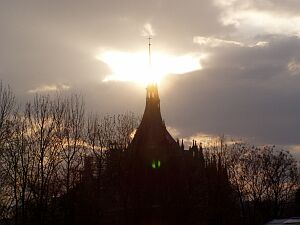
| ||
| Sundown above St. Barbara cathedral |
The whole city stretches from the west to the east, with some smaller mountains in the north and railtracks running parallel with tiny Vrchlice river in the south. To the west, the valley of Vrchlice gets deeper and deeper. Right in the middle of the old town, Palackého nám. (palace square) (see photo below) can be found. Most sights and the oldest buildings of town concentrate in a triangular between St. Barbara cathedral, Kamenná kašna (stone well) and Palackého nám. It's a rather small area, full of interesting places. But there are two main attractions in Sedlec as well (see below: sights).
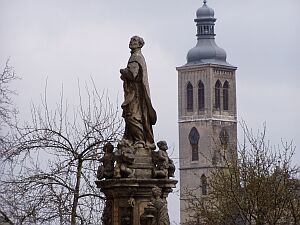
| ||
| View from the Jesuit College to St. Jakob church |
History
Today, Kutná Hora is just a small city among many others. It wasn't always like this. During the 14th century, the town was the second biggest city of Bohemia - #1 of course was →Prague. Flashback: During the 13th century, a large and rich silver mine was found in (not near!) Kutná Hora. Needless to say that silver was very important at that time as well, and so people started to massively exploit silver. Then the precious metal was processed and turned into so called Silbergroschen (silver penny). In late medieval Europe, the silver penny was the most important hard currency. Thanks to the silver, the town blossomed.
Time of prosperity lasted until the 16th century, when Kutná Hora's silver deposits were exhausted. The last mine was given up and sealed in 1726. With the wisdom of hindsight, the sudden end of Kutná Hora's boom was a good thing. Nothing changed after the economical decline - the medieval city has been perfectly preserved. That is way the entire historical centre was declared UNESCO world heritage in 1996.
When you walk attentively trough old and new Kutná Hora, you will see that most of the industry is down. The major source of income is tourism and a modern cigarette factory run by Philip Morris. Surprisingly, the number of visitors is rather low - much lower as for instance in →Český Krumlov.
Getting there / transportation
Most trains arrive at the Kutná Hora Hlavní Nadraží (main train station) near Sedlec. From there, buses, taxis and a very small train go to the inner city. The train station close to the historic centre is simply called Kutná Hora město (=city). The train between both stations need 7 minutes only. The departure and arrival time corresponds with the time of major trains passing through, so there's no need to wait longer than 5 minutes for a connection train. Some of the small trains continue to Zruč nad Sazavou.
From the main train station, there are several trains a day to →Prag Hl.n. and/or Prag Libeň (the latter is not very central). Most connections require to change trains in Kolín, which is only 10 minutes away from Kutná Hora. From there it's around 45 minutes to Prague. Some trains continue all the way to →Cheb in the very west of Bohemia. The fare to Prague is 55 Kč (one way).
Some trains from Kutna Hl.n. are bound for →Brno in Moravia. It takes more than 2½ hours, the return fare is 230 Kč.
As already mentioned above, the south-west limit of the city is marked by the Chrám sv. Barbory - St. Barbara cathedral. There are higher buildings in town, and so the cathedral is not easy to be seen from the centre. Once you stand in front of the church, you will be astonished - such a marvellous building in a place like this? The construction of the cathedral began in 1388, but it took more than 150 years to complete the structure. It was designed by Petr Parléř, the famous architect of the marvellous St. Vitus cathedral in →Prague castle.
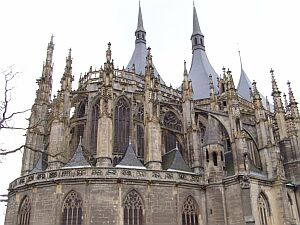
| ||
| St. Barbara cathedral at daytime... |
Obviously, French cathedral gothic style had been imitated. The tent-shaped roof is quite remarkable, but it's not original. Until 150 years ago, the roof had three towers as well but it was much simplier. The back of the cathedral is under reconstruction (as of 2004) and therefore partially surrounded by scaffolding. Entrance fee to the church is 30 Kč (reduced 15). Be aware that opening hours are quite unusual. It's not allowed to take pictures inside.
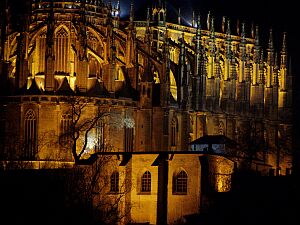
| ||
| ...and at night |
When standing in front of the cathedral entrance facing the city centre, you will see a small building to the left. The flat building with an observation platform on the top is the so-called Corpus Christi Chapel. It consists of one large empty hall only and is much bigger than you'd expect. Inside there are four large columns and three big windows - that's it. The chapel was constructed between the 14th and 15th century and was supposed to be used as an ossuary (charnel-house). What is special about this empty hall is the fact that this is one of only a very few perfectly preserved pure Gothic rooms. It's only possible to see the chapel with a guide (Czech only). Admission fee is 20 Kč (reduced 10), and it's well worth the money.
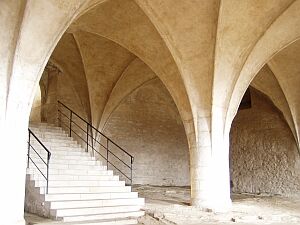
| ||
| The purely gothic Corpus Christi chapel |
When you walk from the cathedral to the historical centre, you will first pass the long, former Jesuit College, founded in the 17th century. The road in front of the college is like a promenade with some beautiful baroque statues on the balustrades to the right. From there, one can enjoy a nice view over the river valley and the old town (see top right picture).
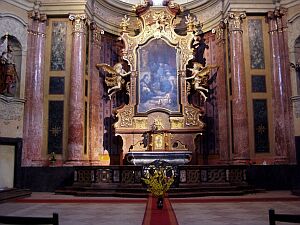
| ||
| Altar inside St. John-Nepomuk church |
When continuing to the centre, you will come across the Hrádek on the right. This was the old town castel and originally constructed as a gothic palace including a tower, but it was rebuilt in 1420 in a different style. Today it houses a museum on silver mining. There a tour leading through the 20 levels of tunnels below the city starts. The lowest level is around 200 meters deep. Be aware: The tour is often booked out. I was turned down twice - 'sorry, we're full'. It would be wise to make reservations before going to the museum. Entrance fee is 110 Kč (reduced 70) - plus the admission fee for the tour.
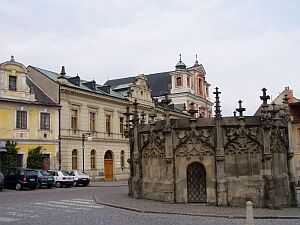
| ||
| The stone well and - in the back - the Nepomuk church |
After a few hundred meters you will have arrived in the 'real' centre. There, it's easy to find the Kostel Sv. Jana Nepomuckého (St. John Nepomuk church). The fact that the church is cramped by two normal living houses is quite unusual. The red and white church is a fantastic example for baroque style - there can't be a 'baroquer'. It was built in the 18th century but it's not in use any longer. However, since 2004 it's possible to enter the recently restored church. Entrance fee is 20 Kč (reduced 10).
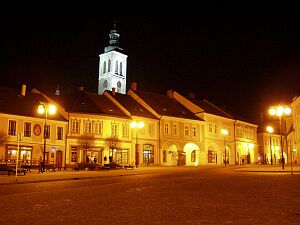
| ||
| Central square and St. Jakob church |
Some 100 m left of the church there is a small square and the odd, round Kamenná kašna (stone well), which was used as a water reservoir. Through a small peep-hole you can look inside and see - nothing. Everyone looks inside and makes the same disappointed face - watching this is just another attraction of Kutna Hora.
When you walk down the Husova-Street from the well towards the Nepomuk church, you will see soon a marvellous pest column to the left. Especially the statue of a young man pierced by some dozen arrows is quite frightening. After 300, 400 meters, the large Palackého nám. (palace square) opens in front of the visitors. All in all it's a nice square, except for the new and ugly Hotel Mědínek, which seems to be the one and only new building around. The tourist information next to the hotel at the north-east side of the square can help arranging accommodation.
South of the square the dominating Kostel sv. Jakuba (St. Jacob church) looms up. The narrow backstreets around the church and the church itself are very beautiful. Many streets branch off from Palackého square. The second street to the right of the tourist information leads to the close Vlašský Dvůr (Italian court). This was the place where coins were minted. Until the 13th century, many different currencies existed throughout Europe, making business extremely difficult and confusing. Therefore, Italian mintage masters introduced the silver penny, which became widely accepted everywhere in Europe - the predecessor of present-day Euro so to say. Kings occasionally used the Italian court as thier residence. The whole complex had been built in the 13th and 14th century. Today, the courtyard is under reconstruction (as of 2004). It's possible to enter the court. Admission fee is 60 Kč (reduced 30).
The Kamenný dům (stone house) north of the Nepomuk church should be mentioned as well. Thanks to its splendid gable it's very easy to find. The stone house (although all other houses are made of stone as well) is a medieval, late-gothic style burgher house and today used as a museum. It's not possible to walk around on your own - a guide leads visitors through the nice but somehow historically mixed rooms. A good place for rainy days. Admission fee is 40 Kč (reduced 20).

| ||
| Assumption of the Virgin Mary - church in Sedlec |
In the flat eastern part of Kutná Hora called Sedlec, the Cisterciánský klášter s kostelem P. Marie (Cistercian monastery and Assumption of the Virgin Mary church ) is a landmark. The gothic building was built in the 13th century as Bohemia's first Cistercian monastery. The whole large complex is under reconstruction since 2002, and seems to take much more time to finish work (as of 2004).
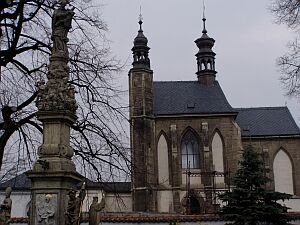
| ||
| Slightly cock-eyed: The Kostnice ossuary |
What draws the visitors' attention most is the Hřbitovní kostel všech Svatých s kostnicí (cemetary church and ossuary 'All Saints'), only 200 m north of the monastery. The small and obviously leaning church stands in the middle of a cemetary, which by the way is still in use. The baroque style church contains ... bones. Tons of bones. It's not the bones of a few or a few hundred people, but all in all of around 40,000 people. Everything inside (incl. the receptionist and the visitors) is made of bones - wall decorations, a candelabrum, something that looks like a bell, the family crest of the Schwarzenberg's and much more. Almost every single human bone, no matter how small it is, had been used...

| ||
| The candelabrum inside the ossuary |
The macabre interior was created by František Rint in 1870. As far as I know, there are two more churches showing a danse macabre - one in →Poland and another one in Portugal. Admission fee to the ossuary is 30 Kč (reduced 50%). A photo permission costs an extra fee. There are information sheets in more than 20 languages available, but they must be returned before leaving.
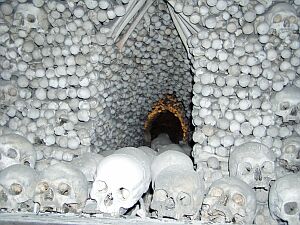
| ||
| By the way...dogs have to keep out! |
Accommodation:
There are a couple of hotels, pensions and even dormitories in town. Pension U kata is very good value and has been extended recently. The price for one person in a 2 or 3 bed room incl. bathroom and toilet costs 200 Kč per night. There is something like a pub downstairs. Staff is very friendly, though no one seems to speak English (except for one young man who seems to belong to the family). It's quite easy to find: Get out of Kutná Hora Město and head for the black church close to the station. You can see the pension from the church and there are signs as well. From the pension, it's only five minutes to the central square as well as to the train station on foot.
Address: Uhelná 569, Tel.: (0327)-51 50 96.
Food and drinks:
For authentic and real good Bohemian cuisine head for the great Dačický (Rakova 8, www.dacicky.com), about 100 meters south of Nepomuk church. A trip to Kutná Hora without going there is not complete. The food is excellent, and so is the beer. Staff is friendly and prices are reasonable, too. Try the garlic soup and the goulash (some sort of stew, see also →Czech food and drinks). The restaurant is hidden in a backstreet, but there are many signs showing the way.
Looking for company? Fancy a drink? Then you might head for Pub u Jakuba (Kolárova 157) right north of the central square and easy to find, since there's a Kilkenny sign above the entrance. Czech beer and liquors as well as the typical Irish stuff such as Guiness, Kilkenny, Jameson etc. (all around 50 Kč) are served in genuine atmosphere.
Café Organzza (I'm not 100% sure about the name) at the south side of the central square has good coffee and biscuits and very friendly staff.
- www.kutnahora.cz/ Official, multilingual website of Kutná Hora. Quite useful to read.
Do you have or do you know a good website about Kutná Hora? Don't hesitate, let me know! After checking it, I would love to add it to the link list. You can submit a link by using the →contact form. Note that commercial websites will be treated differently.
©2024 Europe-East.com

 Albania
Albania Czech Republic
Czech Republic